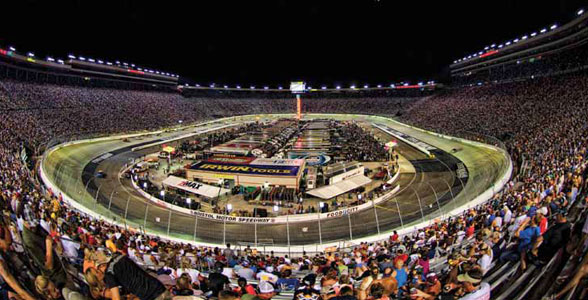By Daniel S. Pierce
I’ll never forget the guy in front of me who stood up every lap and saluted Dale Earnhardt with an extended middle finger.August 1994 was a momentous month for me. I left UT with a half-finished dissertation, moved to Asheville, North Carolina, to begin a career as a college teacher, welcomed my third child into the world, and went to my first NASCAR race at Bristol Motor Speedway. I won’t shortchange my son Sully by putting his birth anywhere but at the top of the list of these events. But my first NASCAR race has to rank near the top of significant things that happened to me that August, and for that matter, near the top of events that have happened to me in my life.
That first race—which I attended with lifelong NASCAR fan, fellow academic, and best friend, Don Good—would shape my life and career in ways I never could have imagined. Indeed, once I finished revising my dissertation into a book (The Great Smokies: From Natural Habitat to National Park [UT Press, 2000]), doing research on the history of NASCAR became an important part of my life’s work and led to the recent publication of Real NASCAR: White Lightning, Red Clay, and Big Bill France (UNC Press, 2010). My research has taken me to unimagined places that include racetracks all over the region, the offices and homes of NASCAR legends, the op-ed page of The New York Times, interviews on NPR, UNC-TV, and SCETV, as well as having the only academic office in the world (at least to my knowledge) with the side of a stock car mounted on the wall.
This journey is even more unlikely since for the first 39 years of my life I had no interest in stock-car racing whatsoever. I grew up within earshot of the Asheville Speedway, yet never went to a race; in fact, I made fun of those who did. I just didn’t get the attraction of watching rednecks drive in circles.
That all changed with my first trip to Bristol. The carnival atmosphere, the noise, the smells, the colorful cars under the lights, and, yes, the crashes overwhelmed my senses. I had the time of my life. Perhaps the thing that attracted me most was the passion of the fans. I’ll never forget the guy in front of me who stood up every lap for 500 laps and saluted Dale Earnhardt with an extended middle finger.
That first experience led me to look into the sport’s rich history, which was even more fascinating. The stories of early drivers hauling illegal liquor one night and racing the same 1939 Flathead Ford V-8 the next; of outlandish characters like Curtis Turner, who once landed an airplane on a city street so he could get some liquor from a friend’s house; of beating-and-banging races at dirt tracks throughout the Piedmont South; and of Big Bill France, who started NASCAR and ruled it with an iron fist and whose family still owns the sanctioning body and most of its tracks, all led me to want to chronicle this cultural phenomenon.
To say the least, I’ve had an unusual career path as an academic. While many family members and friends don’t understand the attraction NASCAR holds for me, they’re generally tolerant. The best explanation I can give is the argument I proffered on a recent TV show where I engaged fellow historian Hardy Jackson in a friendly debate on the question “Which Sport is More Important to the South: Football or NASCAR?” While football is incredibly popular in the South, it was a gift to the region. NASCAR—like jazz, the blues, country music, bluegrass, Andy Griffith, and the Moon Pie—is a wonderful cultural gift from the South to the world.
Daniel S. Pierce is chair of the History Department at the University of North Carolina at Asheville.



